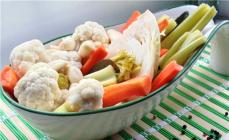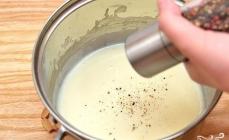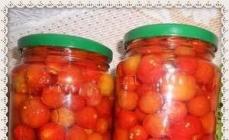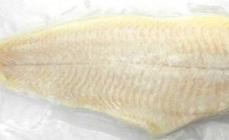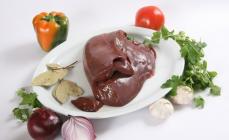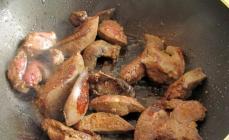If you wish to prepare something delicious and useful people Frequently faced with the fact that the components of the dish in recipes are represented in grams. The products are solid, liquid, bulk, viscous, etc. How to measure the very grams? Experienced hostesses have already solved this problem.
Weight and volume ratio

From the school course it is known that various substances have different density, and, consequently, the same weight can occupy a different volume.
Not everyone in the kitchen has scales for products, but they are not always useful. For example, weigh 50 g of flour or 70 risa - not very convenient and takes a lot of time. If you follow the recipe and measure the necessary grams using weights, cooking will take so much time that no mistress will be satisfied with the results of your work, even if the dish is delicious.
As a rule, accuracy is required when experiments with new dishes, as well as with diet and unloading days. What is already known and passed, is usually done on the eye, i.e. Experience comes with practice.
But how to be the one who starts something new? For such, there is a measuring table in which it is presented how much volume occupies a certain amount of bulk products.
What is the gravity of measuring products in the kitchen? Yes, what is at hand - spoons, glasses, banks, etc. From this and proceeded when drawing up a table. To keep it before your eyes and, if necessary, periodically addressed to it - convenient and useful.
Table

The measuring table shows which volume is 100 g of bulk products, and not in milliliters, liters, etc., and in spoons and glasses.
| Product | Teaspoon g | Tablespoon, g | Ground glass (200 g), g | |
| Salt | 10 | 30 | 260 | 325 |
| Sugar | 12 | 30 | 160 | 200 |
| Soda | 12 | 28 | 160 | 200 |
| Powdered milk | 5 | 20 | 95 | 120 |
| Lemon acid | 10 | 30 | 250 | 300 |
| Gelatin powder | 5 | 15 | - | - |
| Starch | 10 | 30 | 130 | 160 |
| Powdered sugar | 8 | 25 | 140 | 190 |
| Poppy | 5 | 15 | 125 | 155 |
| Cocoa | 7 | 20 | - | - |
| Ground coffee | 10 | 20 | - | - |
| Wheat flour | 10 | 25 | 130 | 160 |
| Rye flour | 10 | 25 | 140 | 170 |
| Fig | 7 | 20 | 150 | 180 |
| Semolina | 7 | 25 | 160 | 200 |
| Buckwheat | 7 | 25 | 170 | 210 |
| Millet | 8 | 25 | 180 | 220 |
| Oatmeal "Hercules" | 6 | 12 | 70 | 90 |
| Pea raw | 10 | 25 | 185 | 230 |
| Crup corn | 7 | 20 | 145 | 180 |
| Groats bang | 7 | 20 | 145 | 180 |
| Pearl cereals | 8 | 25 | 175 | 230 |
| Sago | 7 | 20 | 150 | 180 |
| Small croutons | 5 | 15 | 110 | 125 |
| Beans. | 10 | 30 | 175 | 220 |
A similar table for spices will also not hurt, only spices are accepted to death with smaller volumes.
Often the volumes are measured by berries. Table.
| Yagoda | Teaspoon g | Tablespoon, g | Ground glass (200 g), g | Slim tea glass (250), g |
| Strawberry | - | 25 | 120 | 150 |
| Raspberries | - | 30 | 145 | 180 |
| Cherry | - | - | 130 | 165 |
| Sweet cherry | - | - | 130 | 165 |
| Red currants | - | 30 | 140 | 175 |
| Smorodine black | - | 25 | 125 | 155 |
| Gooseberry | - | 35 | 165 | 210 |
| Blueberry fresh | - | 35 | 160 | 200 |
| Blueberry dried | - | 15 | 110 | 130 |
| Cranberry | - | 25 | 115 | 145 |
| Lamberry | - | 20 | 110 | 140 |
| Blackberry | - | 30 | 150 | 190 |
| Blueberry | - | 35 | 160 | 200 |
| Rosehip dried | 6 | 20 | - | - |
| Raisins | - | 25 | 130 | 165 |
Many love to use in cooking such useful and delicious productlike nuts. Table.
Some subtleties

Data on the ratio of volume and weight of bulk products may not seem fairly accurate. The fact is that in the kitchen we use that kitchenware, which is on hand. Tea and tablespoons that we use can vary greatly in size and accommodated volume. For example, there are teaspoons with a volume of 2.5 and 5 ml, there are dessert spoons of 10 ml. Table spoons are also distinguished by a variety. There are large tablespoons with a scope of 7 cm long and 4 cm wide, - they contain 18 ml of water. There are very small, with a scope of 5 cm long, they contain 12 ml of volume. There is an average - a volume of 15 ml.
A faceted glass, which is present in the table as a container, has long gone in the past. Do not everyone knows how he looked. We focus on the fact that he accompanied 200 ml of water. Today, many tea cups contain the same volume.
To specify the stated amounts of volume, which contains a table, take the following values:
- Teaspoon - 5 ml.
- Tablespoon - 15 ml (or 3 teaspoons).
- A grunge glass - 200 ml (13 tablespoons or 40 teaspoons);
- Standard glass (slim tea) - 250 ml (1.25 grungy glass, or 17 tablespoons, or 50 teaspoons).
Guided by these measures of volume, you can choose dishes, which will most accurately comply with the specified ratios. Find houses comfortable in the use of capacitance for bulk products that meet the necessary criteria is easy. When choosing, if necessary, it is better to use weights and standards.
Today, there are a large range of various measuring containers for products - glass, plastic, etc., with a volume of several milliliters and above. This purchase will not cost expensive, but it will be very useful for the kitchen. Measuring containers for products are able to replace kitchen scales and facilitate homemade work.
Taking care of culinary creativity, you need to do accumulating and do not rush. In the process of cooking dishes, do not forget about the rules for which it is necessary to measure bulk products:
- Push the product into the measuring container neatly, light movements, do not tramber it.
- The measuring tank for products should be dry and clean.
- All calculations in the table imply that bulk products in the dimensional capacity of fasteners "without a slide".
Using such a useful tool as the proposed measuring table, you can easily cope with any recipe, save your strength and time. And let the result benefit you and your loved ones.
You may also be interested
How to measure flour? It is more convenient for these purposes to use ordinary weights or a measuring glass. But what to do if they are not? In this situation, it is possible to determine the required weight of flour through a faceted glass or a tablespoon. Experienced hostesses know that this method is no less reliable than weighing as weights.
How to use a glass?
How to measure the weight of flour to use a glass? It is very easy. We will proceed from the fact that the faceted glass with a rim is 250 milliliters of the liquid, and in the tank without a rim - 200 milliliters. We will measure on the example wheat flour top grade. Moreover, it must be uneasyful.
So, approximately 160 grams of uneasy flour is placed in a faceted glass with a rim. Capacity without rim is capable of accommodating 130 grams of dry ingredient (if more precisely, 128 grams), if you pour out without a slide. This amount (130 grams) of wheat flour will be in a container with a rim if you pour dry ingredient on the rim. This measurement method is convenient when you need a lot of wheat flour, which is relevant for baking recipes of buns or pies.
And consider that I need to pour flour into the glass like this:
I need to dump the flour that was not asked. If you sift the dry ingredient, and then return to the faceted glass, it does not fit.
If there is no faceted cup, not trouble. Surely at home there is a tea cup. The calculation of the desired volume is made arithmetic by the formula: (A (the volume of the cup in milliliters) * 160 (weight of flour in a graved glass with a rim in grams)) / 250 (the volume of the faceted glass in milliliters) \u003d in (weight of flour in a cup in grams). The calculation is extremely simple. So, let's say the tea container accommodates 180 milliliters of the liquid. Then it is necessary to consider this: 180 * 160/250 \u003d 115.2. Accordingly, 115.2 grams of wheat flour will be placed in a cup of 180 milliliters.
As a basis, when calculating the formula, you can take a faceted glass without a rim or other container. But consider that in this case you will have to change the volume in milliliters. By the way, the sugar is measured in the same way as wheat flour.

How to measure flour with a spoon at home?
Measuring flour at home with a spoon - a method for more than a long compared to the measurement using a faceted glass, but no less reliable. So, in a shallow spoon of a table type, which is considered ordinary, about 20 grams of flour is placed if you pour out without a slide. If there is a wheat flour with a slide, then in the specified table device can fit from 25 to 40 grams.
There will be approximately 10 grams of flour in a teaspoon (when scolding without a slide. To adhere to this method is convenient only if the dry ingredient is necessary in a small amount, for example, to create a face mask.
Weight rye flour The coarse grinding is somewhat different in the biggest. In the dining spoon without a slide contains about 25 grams of dry ingredient.

A typical mistake of many owners when measuring flour without weights is becoming that everyone remembers the volume of a glass of 200 milliliters, carrying this value and on the weight of the dry ingredient. This is an erroneous opinion.
There are no difficulties in the measurement of flour without weights. Just adhere to the recommendations that are described in the article - and everything will turn out. Using the above formula, you can measure any amount of flour, knowing the volume and weight used for measurements of the container - liter or half-liter cans, measuring cup.
How many grams of water, cereals, sugar or salt is fitted in a tea or tablespoon - how to measure the necessary weight of products without weighing?
Conveniently, when the number of spoons of cereals or sugar glasses is indicated in the recipes ... And if you need to measure 130g sugar, but there are no kitchen scales? 
An article to help! I appeal to her very often! That is why I place it here.
1 teaspoon(filled with "without a slide" / "C slop", with normal humidity) contains gr.:
water - 5 / - g (gram)
Milk - 5 / - g
vegetable oil - 5 / - g
Sugar - 5/7 g
Salts - 7/10 g
Flour - 4/5 g
Rice - 5/8 g
Drug Grass - 2/3 g (dry grass weight)
Manna Crupes - 4g
1 tablespoonfilled with "without top" / "with top", accommodates (weighs in grams, for a full-size spoon with a length of 7 centimeters and a width - 4 centimeters):
wATER - 18 / - G
Milk - 20 / - g
vegetable oil - 17 / -
Sugar - 20/25
Salts - 25/30 gr.
Flour - 10/15 g
Rice - 15/20 g
Hammer nuts - 10/15 gr.
Dry herbs - 5/10 g
Fresh herbs - 10/15 g
semolina cereals - 20g
Cocoa - 25g
sugar powder - 20g
In a dessert spoon (more tea, but less dining room):
water - 12 / -
Milk - 12 / - g
Sahara - 10/15 g
Salt - 14/20 g
Flour - 7/12 g
Rice - 12/17 g
Hammer nuts - 8/12 g
Dry herbs - 4/6 g
Raw grass - 8/10 g
Note: As a rule, if it says "one dining room (tea) spoon", we are most likely about a full spoon - "with a slide"
1 cup ("To risks" / "to the edge", with conventional indoor air humidity) contains products in grams:
water - 200/250 g (maximum weight of 250 grams (\u003d 250 milliliters) - a glass full, filled to the top)
Sahara - 200/250 g
Salt - 290/320
Flour - 140/150 gr.
Rice - 210/230
Manki - 200/220 g
Stoken nuts - 140/150 g
vegetable oils - 245g
Hercules - 130gr
Sugar powder - 200g
1 cup ("with a slide") accommodate
11 tablespoons of cereals
10 tablespoons of sugar or salt
1 gram of water \u003d 1 milliliter of water \u003d 1 cubic centimeter of water, By weight (that is, having a standard syringe for twenty milliliters with conventional water, you can get a reference weight from 1 to 20 grams with an accuracy of grams, as well as - volume up to 20 cu. See)
The weight of fruits and vegetables with an average size:
quince 150-200gr
Eggplant 150-200gr
Cabbage (Kochan) 1200-1500 gr
Cabbage Color 800 gr
Potato75-100 gr
Lukovitsa 75-80 gr
Carrot 75-100 gr
Cucumber 50-100 gr
Tomato 80-100 gr
Beets 100-150 gr »Alt \u003d» »/\u003e
How to measure flour glass
Well, if a simple faceted glass was lit in the farm. It is believed that 200 grams of water is placed in it. But this does not mean that the flour will go there as much. In how to measure the flour with a glass, there are some tricks.
- First, flour must be covered with a spoon, and not to scoop out of the pack right glass. Otherwise, emptiness of the walls are formed in the container, and flour will fit less. Glass fill without a "slide".
- Secondly, the flour in the glass is not tamping, but also do not break.
Made everything right? In the graved glass you will have 160 grams. If the flour is tumped, then it will fit it in a glass of 210. If you first sift and disintegrate, then only 125
There are still ways to measure flour. We give a small table that will help you at the right moment take the right amount of flour:
Ideally, of course, it is better to produce control measurements. Ask girlfriend kitchen scales. Greek flour once in a glass and spoon. Write down the data, hang them somewhere in a prominent place in the kitchen. Then, if necessary, you can always measure the desired amount of flour.
Keep in mind if you incorrect me flour, then the results can be different. Silver and blind flour in the glass will be more.
How much hang in grams
All would be good, but most often you need not 160 and not 25 grams. Usually in recipes appear "round" numbers. Here and the question arises, for example, how to measure 100 grams of flour?
The easiest "on the eye" squeeze extra 30 or 60 grams from the glass (depending on the glass), that is, 100 grams it will be a little more than half of the tea and slightly less than half of the faceted glass. You can put 4 tablespoons without a slide. There is a more cunning way. It will require time from us and some non-slip fixtures.
So, we need a ruler and a blank sheet of paper. On the sheet, Blacksmith Rectangle 10 for 20 centimeters. On large sides (20 cm), I refue 2 cm, we put the points and connect them with lines. We have a rectangle 10 for 2 cm. So?
Pour a kilogram of flour on paper. Uniformly distribute it along the greater rectangle, what we painted at the beginning (20x10 cm). Watch that the flour does not get out of the rectangle. Then neatly the knife separate the part that it occupies a smaller rectangle (10x2 cm). This is 100 g.
Similarly, we do when we do not know how to measure 200 grams of flour. Only then measure it on the 20-centimeter side not 2, but 4 cm. Next is the same in the algorithm. By the way, this method is suitable for measuring sugar or cereals.
How to measure grams without weights
Clearly observe the proportion and put a strictly specified number of cereals, water, spices - the key to any successful dish. It is especially important for baking. If you accidentally add more or less torching than required, the dough will come out absolutely not like that. In the absence of a special device, it will be able to remove it with other infirred means. Each hostess will use information about how to do it right.
How many grams grams gram flour
First of all, it is worth saying that this item is a faithful assistant in measuring products for many owners. It is very accurate and will surely help you easily score the desired volume of any liquid or bulk substance. If you fill the top grade wheat torch to the top with the cap, then it will be 160. This value is approximate. If the vessel fill in the rim, then it will be 130 g.
If you do not know how to measure flour without weights, use these tips:
- The grain products should be uneasyful. It is not necessary to try to kill the torch from the general package, but carefully pour out in small portions. Otherwise, the walls of the dishes are formed by emptiness, due to which the volume is not enough for the dish.
- Do not tamper dry substance, do not knock on the vessel when filling. Because of this, the result will be completely different.
- Use the table where data is contained on the volume of different products. It can easily be found online.
- It is advisable to choose separate dishes for your measurements, as accurate as possible, and always use it only. If you take different ways every time, the same disof of the dish may differ in taste or completely spoil.

How many grams of flour in a tablespoon
For some recipes, it takes quite a bit like then to be? In this case, it should be measured with spoons. This is an easy task. It is necessary to determine how many flour in the tablespoon. If with a slide, then 25-30 g, depending on which it will be in height, and if without it, then 20 g. 1 tsp. It contains from 9 to 12 g. The dessert will fit 15-20 g. These values \u200b\u200bare correct if the grain products are dry, because the wet will be harder. It is still necessary to remember that some cutlery, especially the remaining from Soviet times, are heavier than modern.
How many flour in a glass of 250 mm
We are talking about a thin-walled product. Such vessels are also called tea. How to measure flour without weights with it? If you fill the vessel, leaving an empty centimeter from above, then you will be released 160. We are talking about wheat. The same makes the corn, because they are the same by density. But rye is more dense, so it will fit 130 g. Potato, on the contrary, it will be easier, it will be 180 g.

How to weigh flour without weights
The device for measuring the mass of products is in the kitchen far from every mistress, however, people are perfectly coping with even very complex recipes. In order to reveal the desired portion, you can use vessels or spoons: dessert, dining room, tea. Having one of these items at hand, you can easily get the required grain rod for baking.
How many tablespoons in the flour cup
Depends on type and fullness. If in a graded 130-160 g, then it will be 4.5-5 tbsp. l. with cap. There are five tea tea. If you take from the first spoon without a slide, it will turn out from six and a half to eight. If you use tea, then 8. Many are incomprehensible how to measure 100 grams of flour, without having a measuring instrument at hand. Everything is very simple: take 5 tbsp. l. without a slide or 3.5 with her. Now you know how many tablespoons in 100 grams of flour.
If you have a faceted glass, then to obtain 100 g, you need to pour so much so that the torch does not take to the rim about the centimeter. There is another way. On a little bit of tormenting, tamping her. To do this, after each new portion you need to thoroughly knock the dishes on the table. Type the highest possible hat, which you can. You will have about 200-210, then from the resulting volume separated about half to the eye. This will be 100 g.

How many glasses in a kilogram of flour
If you have a lot of grain products, it is easy to divide it for a portion. To do this, it is necessary to have an idea of \u200b\u200bhow many glasses of flour in 1 kg. Remembering all the above information, it is very easy to conclude. If you do not know how to measure flour without kitchen scales, use a faceted glass. If you fill to the rim, it will turn out 7.5-8 units, depending on the density of grain products and the humidity level. If you fill the container to the top, then 6-6.5 pieces will be released. In the case of tea, the amount will be the same when filling to the rim.
The Internet today is simply filled with all sorts of recipes, including various baking. In many of them, the number required products It is provided in grams that for inexperienced culinary and confectioners presents some difficulties. Of course, it would be nice to have electronic scales that are characterized by high accuracy and ability to determine the mass of even a very small amount of matter - up to several grams. But if they are not there and there is no opportunity to priese? How then to measure the desired volume of ingredients? In fact, there is nothing easier. Just just know the capacity of some cutlery, spoons, glasses, etc. Here are some recommendations on this.Of course, the easiest way is to measure the product on the eyes. Many experienced mistresses do this. To do this, you need to have a good eye, as well as know the taching capacity. But there is one catch. If there is a packaging of 1 kg in your disposal, then the shelter will not make much difficulty. Although in any case the result will be not the most accurate. It will be much more difficult to cope with such a task when it takes from the pack weighing 1.5 kg to separate 275 g of flour. There is no eye of the eye meer. In such cases, it is recommended to resort to more accurate measurement methods.
For baking recipes, it is usually characterized by the use of a large amount of flour. In such cases, the most ordinary faceted glass will become an ideal measuring means. Before use, it should be washed, and then thoroughly wipe with a dry towel made of tissue well absorbing water. If this is not done, then the flour will pour on the walls and it will create certain difficulties. So, the prepared glass is buried to flour so that it fills the container with a slide. Then, with the help of a knife carefully remove the slide. After all manipulations are done, approximately 150 g of flour will remain in the glass. The error of this method of measurement is very small - plus-minus 5 g, which is simply an insignificant difference in comparison with the required baking volumes.
The lack of such a method is that it can be measured only the volume of round values \u200b\u200bin 150 g increments, that is, 150, 300, 450, etc. A small space for maneuver opens with risks on a glass, that is, a special horizontal line.
If it is filled with a glass of liquid to this mark, then it turns out exactly 200 ml, if the flour - 130, however, operate in two these values \u200b\u200b- 150 and 130 g, is unlikely to measure, for example, 250 g or 110. Therefore, the most faithful Method to acquire a special measuring cup, on the transparent wall of which divisions are applied, allowing to very accurately determine the number of products fastened into it. Today, such products in a large assortment are present in business stores. Moreover, they can be used to measure not only flour, but also any bulk or liquid products.
Sometimes there is only one type gradation on measuring glasses, intended for determining the volume of fluid. Of course, you can measure the flour and with the help of such a container. For this, it is enough to know the density of the substance, which, when multiplying, gives a mass. The density of flour is such that 1 ml of volume contains 0.65 g. Thus, 100 ml is 65 g of flour. This method has two essential drawbacks.
First, it is required to make calculations, albeit very simple, but still.
Secondly, on measuring glasses is present, mainly divisions corresponding to round numbers. For example, if you need to measure 75 g of flour, it will be 115 ml. You are unlikely to find the appropriate division on the scale.
Also, flour is used not only for baking, but also in other recipes. For example, for breading or giving a mixture of liquid products of the desired thickness and viscosity. In such cases, the amount of flour lies in recipes is limited to a small mass - from 10 to 50 g, so it is better to use spoons or tea-dining or tea to the measurement.
In the first case, first will have to choose a spoon, the dimensions of which are responsible to generally accepted standards, because today each manufacturer relieves developing its own original design. As a result, the volume of tablespoons can vary greatly. At the same time, there is a standard for such products and when the recipes are mentioned a tablespoon as a measure of weight and volume, it should be remembered that there are generally accepted dimensions. For us, it is not necessary to know all the proportions, it is enough that the stratification capacity should be 7 cm in length. Such a tablespoon filled with a slide, accommodates 15. If the volume of flour is aligned with a knife along the edges, that is, to remove the mountain, then 10 g of flour will remain in the spoon. Another important detail, if in the recipe the required amount of flour is indicated immediately in tablespoons, then spoons with slides are meant.
If you need to measure a very small amount of flour, then the best assistant will be a teaspoon - the length of the skipping part is 5 cm. If with a slide to fill such a cutlery with flour, then it will turn out to be 12 g. Without a slide, a teaspoon accommodates 7 g. Although the slides are different ...
Do you happen to fall into a slight confusion, if the recipe indicates the amount of product not in pieces or in packs, and in grams? Well, if there is a kitchen scales at hand. This convenient device will help accurately measure the required amount of any product. And how to measure flour without weights? For this there are special measures of measures that will be carels in any situation.
Accuracy - politeness not only by kings
Of course, there are recipes that are observed conditionally and approximately. At the same time, the exit is the highest quality product. But some of them (especially gentle baking) require compliance with special accuracy. A little more than one or another - and all the efforts of the Nammark.
Most often it concerns the flour. Put a little - the smear is obtained, does not hold the form. And if a lot - there will be a tear. How to measure flour without weights? It's not so difficult, let's learn together.
First assistant
The easiest way to take an ordinary glass that everyone has in the kitchen. Moreover, it is best that, Soviet, faceted glass is coping with its function. Today, you can meet a variety of variations in the market, and the amount of products they can accommodate differently.
If you are looking for a reliable way to measure flour without weights, the faceted glass will be a great solution. If you fill it to the edges, it contains about 160 g of the wheat flour of the highest grade. Compare a flour on top risk, you get about 130 g.
The end result affects the fact that you sieved flour. If you have to fill the glass to the edge, and then pour the content into a sieve, then after sieving flour it will not fit into it. If you are thinking how to measure flour without weights, then it is better to first dial the desired amount, and then sift.

Typical errors
So how to measure flour without a glass of a glass is quite convenient, some hostesses constantly use this way. But at the same time, with surprise, they noted that the dough is not always successful. What is wrong? The fact is that more often the hostess remembers only 200 ml. The same measure is transferred to flour. But, as we have already said above, it is much smaller in full glasses.
Using a spoon
If the glass was not at hand, or a lot of them, but there is no exactly that, as it should, you can use the tablespoon. In this case, it will have to spend much more time, but the measurements will be more accurate. Suppose you solve the task how to measure 100 grams of flour without weights. At the same time, you only have a tablespoon. There is nothing easier. In the standard cutlery, the length of the scary surface of which is 7 cm, is located 15 g of flour. This is if you count with a slide. Without it - 10 g. It becomes clear that it will take 6 spoons with a slide and one without it. In this case, you will receive the desired 100 g.

For the most accurate measurements
If the error is unacceptable, but at the same time you need to measure a very small amount fluent productYou can take a teaspoon. In this case, you will be guided by the following indicators. Filling the spoon to the edges, you get 4 g of flour. If you leave the hill, it will be 5 g. As you can see, nothing complicated. And then - the standard course of school mathematics: count how many spoons you need, and begin to measure.
Measuring cup
Usually it is in each kitchen. Such cups are available complied with a slow cooker or bread maker. How to measure 300 grams of flour without weights, with one such cup? Here we will be guided by the fact that 100 ml of flour is approximately 65. Based on this, it is possible to calculate how much such cups will be taken. In our case, 4.5 pcs will be required. Of course, the numbers are a bit approximate.
If the dimensional capacity is calculated for a larger volume, then it can be counted that 100 g of flour is 153 ml. So it will be possible to make a corresponding mark and calmly measure the flour every time.

On the eye
In this way, every hostess has ever used. How to measure 500 grams of flour without weights? There is nothing easier. Most often we buy flour, packaged in packages. It can be a kilogram or twokilogram packaging. All that is required from you is to measure half or the fourth part. Of course, there will be a certain error. But if it is not too critical, you can use it in this way.
Do it yourself
It is almost all the ways that allow you to do without kitchen scales. Of course, if necessary, you can invent a few more. For example, you can go to the nearest store and ask you to reassure exactly what is required. In this case, returning home, you just wipe the flour into a cup and begin to cook.
Some mistresses go a little further. They buy a kilogram packaging in the store and pour it into the jar prepared in advance with a lid. From the outside, a mark is made, which corresponds to the 1000 g. Now we divide exactly in half and get 500 g. Marks can be done as it will be convenient. For some, it is divisions of 200 g, but less should not be done, because to measure in such a way 50 g will be problematic in any case.

Instead of imprisonment
Measure flour without weights is not as difficult as it may seem at first glance. And it is not so important how much product is required to be removed as a result. For example, to a kilogram, you can definitely measure with a spoon or cup. And what if required 7 or 12 kg? It is enough to fall asleep one kilogram into any container that will now be measured and risk.
Now it is your measure. By the way, experienced hostesses often use this method. They know well that exactly half (one and a half, two) kilograms climbs into a certain cup, so if necessary, it can use it.

